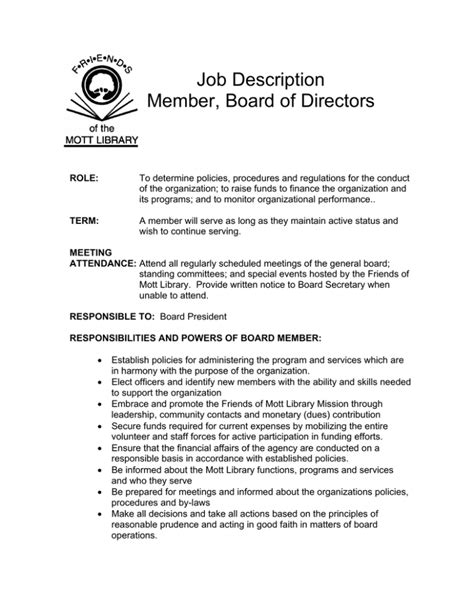Board Of Director Titles & Job Descriptions

When it comes to the governance and decision-making of a company or organization, the board of directors plays a crucial role. The board is responsible for setting the strategic direction, overseeing operations, and ensuring the organization’s success. In this article, we will explore the different titles and job descriptions within a board of directors, highlighting their responsibilities and contributions.
1. Chairman of the Board
The Chairman of the Board is the highest-ranking individual within the board. They are responsible for leading the board meetings, ensuring effective communication among board members, and representing the organization externally. The Chairman also collaborates with the CEO or managing director to set the meeting agendas and guide the overall functioning of the board.
2. Board President
The Board President is an elected or appointed position within the board. They work closely with the Chairman to support the board’s activities and ensure the organization’s goals are achieved. The Board President may also act as a liaison between the board and the CEO, providing regular updates and facilitating effective communication.
3. Vice Chairman
The Vice Chairman is the second-highest-ranking individual within the board. They assist the Chairman in their duties and may act as a substitute in their absence. The Vice Chairman also collaborates with other board members to address significant issues and support the board’s decision-making process.
4. Secretary
The Secretary is responsible for documenting and maintaining accurate records of board meetings, including minutes, resolutions, and official correspondence. They ensure compliance with legal requirements, such as filing necessary documents and maintaining a register of members. The Secretary also plays a critical role in facilitating communication within the board and with external stakeholders.
5. Treasurer
The Treasurer oversees the financial aspects of the organization and ensures sound financial management. They work closely with the finance department to review budgets, financial statements, and investment strategies. The Treasurer also provides financial guidance to the board and ensures compliance with financial regulations and reporting requirements.
6. Independent Directors
Independent Directors are individuals who are not affiliated with the organization or its stakeholders. They bring an unbiased perspective to the board and provide valuable insights based on their expertise and experience. Independent Directors contribute to strategic decision-making, oversee corporate governance practices, and ensure transparency and accountability within the organization.
7. Committee Chairs
Committee Chairs lead specific committees within the board, such as audit, compensation, or governance committees. They are responsible for organizing and overseeing committee meetings, ensuring the committee’s objectives are met, and reporting back to the board. Committee Chairs also collaborate with other board members and the CEO to address relevant issues and make informed decisions.
8. Advisory Board Members
Advisory Board Members are individuals who provide specialized expertise and guidance to the board. They may not have voting rights but offer valuable insights based on their industry knowledge and experience. Advisory Board Members contribute to strategic planning, risk management, and innovation within the organization.
9. Non-Executive Directors
Non-Executive Directors are individuals who do not have day-to-day involvement in the organization’s operations. They bring an independent perspective to the board, ensuring effective oversight and governance. Non-Executive Directors contribute to decision-making, risk management, and performance evaluation.
10. Directors-at-Large
Directors-at-Large are board members who do not hold a specific title or represent a particular constituency. They provide a broad perspective and contribute to the overall functioning of the board. Directors-at-Large collaborate with other board members, share their expertise, and actively participate in decision-making processes.
Conclusion
The board of directors is a diverse group of individuals who collectively contribute to the success of an organization. Each board member has a specific title and job description that aligns with their responsibilities and expertise. By working together, the board ensures effective governance, strategic decision-making, and the achievement of organizational goals.
Frequently Asked Questions
1. How are board members selected?
Board members are typically selected through a nomination and election process. They may be nominated by existing board members, shareholders, or other stakeholders.
2. What is the term length for board members?
The term length for board members varies depending on the organization’s bylaws. It can range from one to several years, with the possibility of re-election.
3. Can board members be removed from their positions?
Yes, board members can be removed from their positions through a vote of no confidence or for other valid reasons outlined in the organization’s bylaws.
4. Are board positions compensated?
Board positions can be compensated, especially in larger organizations or those with higher levels of responsibility. Compensation may include a stipend, reimbursement for expenses, or stock options.
5. How often do board meetings take place?
The frequency of board meetings varies depending on the organization’s needs and requirements. They can be held monthly, quarterly, or annually, with additional meetings called as necessary.
